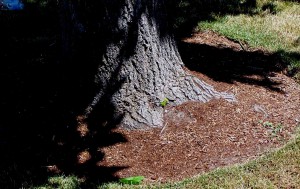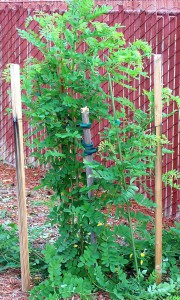Torture stakes were used centuries ago as a slow means of executing prisoners. Unfortunately, the practice lives on every time someone incorrectly stakes a newly planted tree. Though I’ve written about tree staking before (click here to read more), I’ll use today’s blog to demonstrate another unintended result of improper staking – decapitation. A normal tree develops taper as it grows. At eye level, a tree trunk is narrower than it is at ground level: that’s taper. As the trunk flares out and morphs into roots (Figure 1), a buttressing structure is created that allows trees to remain upright, even under windy conditions.
 Figure 1. Trunk flares as it meets soil and roots begin.
Figure 1. Trunk flares as it meets soil and roots begin.
A tree that’s been staked too high, too tightly, and/or for too long does not have this structural protection. Instead, the staking material creates an unnatural pivot point, which is not structurally capable of withstanding wind. When the inevitable windy day comes along, the trunk snaps at this point (Figures 2-3):
Figures 2 and 3. Tree decapitation, up close and personal.
Unlike the victims of the original torture stakes, trees don’t necessarily die after breakage. They are, however, permanently deformed and have little aesthetic value. If trees need to be staked at planting (and many times they do not), staking needs to be low and loose to allow taper to develop normally. (More information on proper tree planting can be found by clicking here.)

